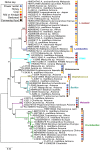Microbial ecology of the hive and pollination landscape: bacterial associates from floral nectar, the alimentary tract and stored food of honey bees (Apis mellifera)
- PMID: 24358254
- PMCID: PMC3866269
- DOI: 10.1371/journal.pone.0083125
Microbial ecology of the hive and pollination landscape: bacterial associates from floral nectar, the alimentary tract and stored food of honey bees (Apis mellifera)
Abstract
Nearly all eukaryotes are host to beneficial or benign bacteria in their gut lumen, either vertically inherited, or acquired from the environment. While bacteria core to the honey bee gut are becoming evident, the influence of the hive and pollination environment on honey bee microbial health is largely unexplored. Here we compare bacteria from floral nectar in the immediate pollination environment, different segments of the honey bee (Apis mellifera) alimentary tract, and food stored in the hive (honey and packed pollen or "beebread"). We used cultivation and sequencing to explore bacterial communities in all sample types, coupled with culture-independent analysis of beebread. We compare our results from the alimentary tract with both culture-dependent and culture-independent analyses from previous studies. Culturing the foregut (crop), midgut and hindgut with standard media produced many identical or highly similar 16S rDNA sequences found with 16S rDNA clone libraries and next generation sequencing of 16S rDNA amplicons. Despite extensive culturing with identical media, our results do not support the core crop bacterial community hypothesized by recent studies. We cultured a wide variety of bacterial strains from 6 of 7 phylogenetic groups considered core to the honey bee hindgut. Our results reveal that many bacteria prevalent in beebread and the crop are also found in floral nectar, suggesting frequent horizontal transmission. From beebread we uncovered a variety of bacterial phylotypes, including many possible pathogens and food spoilage organisms, and potentially beneficial bacteria including Lactobacillus kunkeei, Acetobacteraceae and many different groups of Actinobacteria. Contributions of these bacteria to colony health may include general hygiene, fungal and pathogen inhibition and beebread preservation. Our results are important for understanding the contribution to pollinator health of both environmentally vectored and core microbiota, and the identification of factors that may affect bacterial detection and transmission, colony food storage and disease susceptibility.
Conflict of interest statement
Figures








References
-
- Runckel C, Flenniken ML, Engel JC, Ruby JG, Ganem D, et al.. (2011) Temporal analysis of the honey bee microbiome reveals four novel viruses and seasonal prevalence of known viruses, Nosema, and Crithidia. PLoS One 6: : e20656. Available: http://www.pubmedcentral.nih.gov/articlerender.fcgi?artid=3110205&tool=p.... Accessed 28 February 2013. - PMC - PubMed
-
- Cornman RS, Tarpy DR, Chen Y, Jeffreys L, Lopez D, et al.. (2012) Pathogen webs in collapsing honey bee colonies. PLoS One 7: : e43562. Available: http://www.pubmedcentral.nih.gov/articlerender.fcgi?artid=3424165&tool=p.... Accessed 8 March 2013. - PMC - PubMed
-
- Mullin C a, Frazier M, Frazier JL, Ashcraft S, Simonds R, et al. (2010) High levels of miticides and agrochemicals in North American apiaries: implications for honey bee health. PLoS One 5: e9754 Available: http://www.pubmedcentral.nih.gov/articlerender.fcgi?artid=2841636&tool=p.... - PMC - PubMed
-
- Pettis JS, vanEngelsdorp D, Johnson J, Dively G (2012) Pesticide exposure in honey bees results in increased levels of the gut pathogen Nosema. Naturwissenschaften 99: : 153–158. Available: http://www.pubmedcentral.nih.gov/articlerender.fcgi?artid=3264871&tool=p.... Accessed 5 March 2013. - PMC - PubMed
-
- Anderson KE, Sheehan TH, Eckholm BJ, Mott BM, DeGrandi-Hoffman G (2011) An emerging paradigm of colony health: microbial balance of the honey bee and hive (Apis mellifera). Insectes Soc 58: 431–444 Available: http://www.springerlink.com/index/10.1007/s00040-011-0194-6. - DOI
Publication types
MeSH terms
Substances
LinkOut - more resources
Full Text Sources
Other Literature Sources
Molecular Biology Databases

